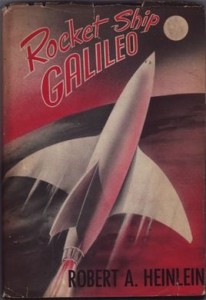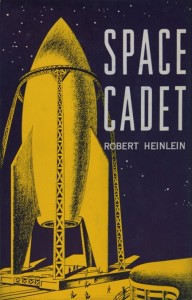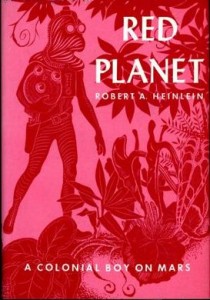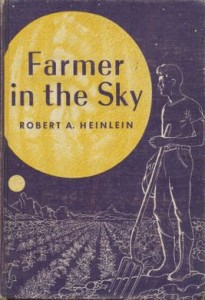
 This is an omnibus volume presenting Robert Heinlein’s first four “juvenile” novels, originally published by Scribner’s in 1947, 1948, 1949, and 1950. Heinlein wrote twelve science fiction novels for teenagers, and put more care and artistry into them than most writers put into serious adult fiction. Their impact has been astonishing, and they remain widely read long after their science and “futurity” has become outdated. They were tremendously liberating for young readers, especially when you judge them in the context of North American society when they were written. Unlike any author writing for young people, up to that time, Heinlein treated his readers with honesty and respect, as well as providing them with a rich intellectual feast. Heinlein struggled with his editors, who constantly panicked over the possible “unsuitability” of his treatment and subject matter. But they were devoured by libraries, and thus were available to people (like me) who were in no position to buy books. Scribner’s published them in a handsome format, with illustrations of great artistic merit by Clifford Geary. I came to them when they were starting to show their age, but their “sense of wonder” and their moral impact remained vivid. Citizen of the Galaxy, for example, was one of the three books that most stimulated my life-long fascination with the issue of freedom and slavery.
This is an omnibus volume presenting Robert Heinlein’s first four “juvenile” novels, originally published by Scribner’s in 1947, 1948, 1949, and 1950. Heinlein wrote twelve science fiction novels for teenagers, and put more care and artistry into them than most writers put into serious adult fiction. Their impact has been astonishing, and they remain widely read long after their science and “futurity” has become outdated. They were tremendously liberating for young readers, especially when you judge them in the context of North American society when they were written. Unlike any author writing for young people, up to that time, Heinlein treated his readers with honesty and respect, as well as providing them with a rich intellectual feast. Heinlein struggled with his editors, who constantly panicked over the possible “unsuitability” of his treatment and subject matter. But they were devoured by libraries, and thus were available to people (like me) who were in no position to buy books. Scribner’s published them in a handsome format, with illustrations of great artistic merit by Clifford Geary. I came to them when they were starting to show their age, but their “sense of wonder” and their moral impact remained vivid. Citizen of the Galaxy, for example, was one of the three books that most stimulated my life-long fascination with the issue of freedom and slavery.
Rocket Ship Galileo (1947) was Heinlein’s first attempt in the series, and it was crude compared to the books that followed. The plot of a scientist recruiting three teenagers to help him make the first flight to the moon because it neither the government nor corporations could afford to do it, and making the journey only to encounter a secret base of escaped Nazis was pretty ludicrous. But it hinted at some of the distinctive elements of the later books. The second, Space Cadet (1948), had a much more believable premise, and included a well fleshed out “future history” context, and great technical accuracy. The plot thin, but much more believable, and the technical detail was exact. The book was so popular, that it triggered a wave of “space cadet” television and radio shows, among them Tom Corbett, Space Cadet and the lost Canadian series Space Command. For a few years, children all across the continent terrorized their parents with plastic ray-guns and bubble space helmets.

 But it was with Red Planet (1949) that Heinlein perfected his art. His evocation of a Martian landscape, a human colony on Mars, and an alien society of Martians was so vivid and detailed that it still seems crisply realistic to reader today, despite the fact that it is all completely impossible. It was, in fact, every bit as impossible when it was written. Heinlein used every trick at his disposal to create a plausible “Mars” based on the ideas expounded by Percival Lovell in Mars (1895), Mars and Its Canals (1906), and Mars As the Abode of Life (1908). In 1949, this vision of Mars had long been discarded by science. But Heinlein’s presentation is so convincing that one completely forgets that it was conceived with tongue in cheek. The same Martian society appears, somewhat differently described, in his adult novels Double Star (1956) and Stranger In a Strange Land (1961). In fact, I can think of no other case in literary history were there exists, in the work of one author, a continuity in themes and detailed content between a story for teenagers and a massive Menippean satire written for adults.
But it was with Red Planet (1949) that Heinlein perfected his art. His evocation of a Martian landscape, a human colony on Mars, and an alien society of Martians was so vivid and detailed that it still seems crisply realistic to reader today, despite the fact that it is all completely impossible. It was, in fact, every bit as impossible when it was written. Heinlein used every trick at his disposal to create a plausible “Mars” based on the ideas expounded by Percival Lovell in Mars (1895), Mars and Its Canals (1906), and Mars As the Abode of Life (1908). In 1949, this vision of Mars had long been discarded by science. But Heinlein’s presentation is so convincing that one completely forgets that it was conceived with tongue in cheek. The same Martian society appears, somewhat differently described, in his adult novels Double Star (1956) and Stranger In a Strange Land (1961). In fact, I can think of no other case in literary history were there exists, in the work of one author, a continuity in themes and detailed content between a story for teenagers and a massive Menippean satire written for adults.
In Red Planet, Heinlein began to give the characters an emotional life with some depth, along with the scientific and social elements. In Farmer In the Sky (1950), the saga of a youth pioneering on Jupiter’s largest moon, Heinlein achieved the balance between emotional issues and science fictional themes that was to characterize all the later books. Young readers learned as much about themselves from getting in the skin of the characters as they learned about the physical world from the scientific content, and were forced to confront issues that were tough and real. The prose style reached the standard that he would maintain throughout the remaining eight titles in the series. If you want to play an interesting, but futile game, try to get old readers of the Heinlein juveniles to agree on which of these books was the best.
contains:
16386. [3] (Robert A. Heinlein) Rocket Ship Galileo
16387. [3] (Robert A. Heinlein) Space Cadet
16388. [5] (Robert A. Heinlein) Red Planet
16389. [5] (Robert A. Heinlein) Farmer in the Sky
0 Comments.